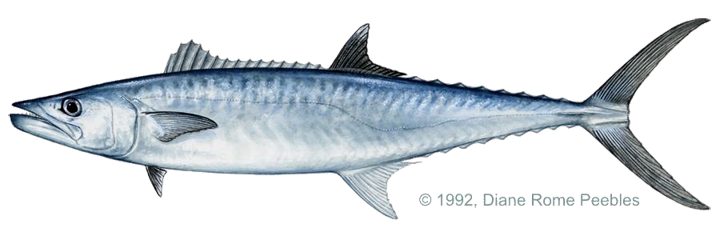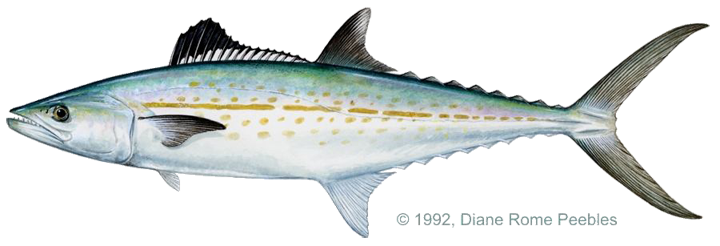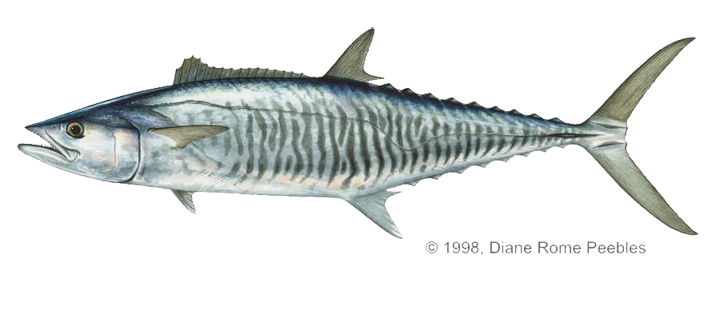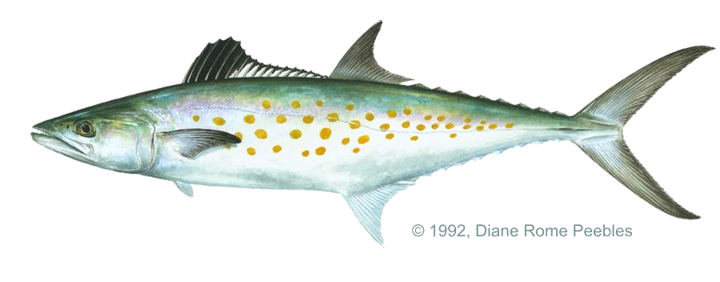Game Fish Identification Reference Guides
Mackerel, king
(Scomberomorus cavalla)
(Scomberomorus cavalla)

(Cuvier, 1829); SCOMBRIDAE FAMILY; also called kingfish, giant mackerel
Found in the western Atlantic Ocean in tropical and subtropical waters, it ranges from Maine in the U.S. to Rio de Janeiro, Brazil, including the Gulf of Mexico, and is common around south Florida in the winter months. This migratory species is constantly on the move. Stocks wintering in Florida migrate as far west as Texas and as far north as Virginia during the summer. It also occurs around south Florida in the spring and early summer months.
A coastal, pelagic, schooling species, it is usually found in waters of 10 20 fathoms. Occasionally it may be caught from ocean piers and around inlets. Congregations often occur around wrecks, buoys, coral reefs, and other such areas where food is abundant. Schools vary in size and the largest individuals are usually loners.
They can be distinguished from other Spanish mackerels in the western Atlantic by the sharp dip in the lateral line under the second dorsal fin, by the relatively small number of spines in the first dorsal fin (14 16). The young have spots similar to those in the Spanish mackerel, Scomberomorus maculatus, but these spots disappear with age. The first dorsal fin is uniformly blue; the anterior third of this fin is never black as it is in the Spanish mackerel and the cero mackerel, S. regalis.
This is an important species, both commercially and as a sport fish. Fishing methods include trolling or drifting either deep or on the surface using strip baits, lures, or small whole baits as well as casting and live bait fishing. Balao, mullet, jacks, herring, pinfish, croakers, shrimp, spoons, feathers, jigs, and plugs have proven effective under various conditions, as have such combinations as feather strip bait and skirt strip bait. Chumming works well to attract and hold these fish
Found in the western Atlantic Ocean in tropical and subtropical waters, it ranges from Maine in the U.S. to Rio de Janeiro, Brazil, including the Gulf of Mexico, and is common around south Florida in the winter months. This migratory species is constantly on the move. Stocks wintering in Florida migrate as far west as Texas and as far north as Virginia during the summer. It also occurs around south Florida in the spring and early summer months.
A coastal, pelagic, schooling species, it is usually found in waters of 10 20 fathoms. Occasionally it may be caught from ocean piers and around inlets. Congregations often occur around wrecks, buoys, coral reefs, and other such areas where food is abundant. Schools vary in size and the largest individuals are usually loners.
They can be distinguished from other Spanish mackerels in the western Atlantic by the sharp dip in the lateral line under the second dorsal fin, by the relatively small number of spines in the first dorsal fin (14 16). The young have spots similar to those in the Spanish mackerel, Scomberomorus maculatus, but these spots disappear with age. The first dorsal fin is uniformly blue; the anterior third of this fin is never black as it is in the Spanish mackerel and the cero mackerel, S. regalis.
This is an important species, both commercially and as a sport fish. Fishing methods include trolling or drifting either deep or on the surface using strip baits, lures, or small whole baits as well as casting and live bait fishing. Balao, mullet, jacks, herring, pinfish, croakers, shrimp, spoons, feathers, jigs, and plugs have proven effective under various conditions, as have such combinations as feather strip bait and skirt strip bait. Chumming works well to attract and hold these fish
















